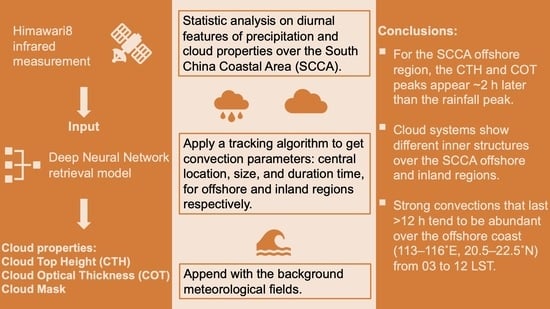Analysis of Diurnal Evolution of Cloud Properties and Convection Tracking over the South China Coastal Area
Abstract
1. Introduction
2. Data and Method
2.1. Precipitation Data
2.2. Cloud Property Retrieval Using the DNN Model
2.3. SAST Algorithm for MCS Tracking
3. Results
3.1. Reproduction of Diurnal Rainfall Pattern
3.2. Diurnal Evolution of Cloud Properties
3.3. MCS Tracking Using the SAST Algorithm
3.4. Meteorological Fields
4. Conclusions
- Similar to the precipitation evolution, ICOT and ICTH showed different diurnal cycles and peak times over the offshore and inland regions. Additionally, a time lag occurred between the rainfall and cloud peaks. Specifically, the offshore ICOT and ICTH reached peak intensities at ~12 LST, which was 2 h after the rainfall peak (~10 LST). Moreover, over the inland region, rainfall and cloud peaks appeared synchronously at ~18–20 LST. This difference in synchronism between the offshore and inland regions suggests that the convection types and internal evolving mechanisms are different over these two regions.
- Upon investigating the diurnal cloud amount evolution of different ice cloud types (Figure 7), over the offshore region, thick clouds were found to approach the maximum amount first, medium-thick clouds reached a peak amount several hours later, and the thin cloud amount eventually increased during the dissipation or re-establishment stages. This process is typical of the evolution of strong convection with a clear phase transition. However, within the inland MCSs, medium-thick clouds first peaked at ~16 LST, which was 3 h ahead of the thick cloud peak, and persisted at a high amount until ~02 LST. The rainfall peak also overlapped with the different cloud configurations in these two regions. These phenomena suggest different cloud structures and features within offshore and inland convections.
- SAST tracking of the daily MCS size and number evolution (Figure 10) also confirmed the different intensities of offshore and inland MCSs and showed that the offshore MCSs are more typical of strong convections that have an apparent diurnal cycle. Furthermore, examination of the spatiotemporal distribution of MCSs with different duration lengths showed that the medium-intensity MCS, which lasts for 9–12 h, is primarily located along the inland coastline, whereas the strong MCS, which lasts over 12 h, is primarily located over the offshore coast from 03 to 12 LST.
- The inland to offshore migration of MCSs was confirmed to occur at ~03 LST (Figure 8 and Figure 11). This migration could be explained by the favorable meteorological environment formed during the same period. From 00 to 03 LST, obvious vertical velocity anomalies appeared over the offshore coast, and southeasterly winds introduced a large amount of moisture from the open sea. Both conditions facilitated the initiation and development of offshore convection at midnight. In addition, an inland to offshore migration of unstable energy was observed at ~00 LST (Figure 13), which serves as a beneficial thermodynamic condition for cloud formation afterward.
Supplementary Materials
Author Contributions
Funding
Data Availability Statement
Acknowledgments
Conflicts of Interest
References
- Chen, X.; Zhao, K.; Xue, M.; Zhou, B.; Huang, X.; Xu, W. Radar observed diurnal cycle and propagation of convection over the Pearl River delta during Mei-yu season. J. Geophys. Res. Atmos. 2015, 120, 12557–12575. [Google Scholar] [CrossRef]
- Jiang, Z.; Zhang, D.-L.; Xia, R.; Qian, T. Diurnal variations of presummer rainfall over southern China. J. Clim. 2017, 30, 755–773. [Google Scholar] [CrossRef]
- Chen, X.; Zhang, F.; Zhao, K. Diurnal variations of the land–sea breeze and its related precipitation over south China. J. Atmos. Sci. 2016, 73, 4793–4815. [Google Scholar] [CrossRef]
- Chen, D.; Guo, J.; Yao, D.; Lin, Y.; Zhao, C.; Min, M.; Xu, H.; Liu, L.; Huang, X.; Chen, T.; et al. Mesoscale convective systems in the Asian monsoon region from Advanced Himawari Imager: Algorithms and preliminary results. J. Geophys. Res. Atmos. 2019, 124, 2210–2234. [Google Scholar] [CrossRef]
- Wang, X.; Iwabuchi, H.; Takahashi, N. Characteristics of diurnal pulses observed in Typhoon Atsani using retrieved cloud property data. SOLA 2019, 15, 137–142. [Google Scholar] [CrossRef]
- Wang, X.; Iwabuchi, H.; Yamashita, T. Cloud identification and property retrieval from Himawari-8 infrared measurements via a deep neural network. Remote Sens. Environ. 2022, 275, 113026. [Google Scholar] [CrossRef]
- Delanoë, J.; Hogan, R.J. A variational scheme for retrieving ice cloud properties from combined radar, lidar, and infrared radiometer. J. Geophys. Res. Atmos. 2008, 113, D07204. [Google Scholar] [CrossRef]
- Delanoë, J.; Hogan, R.J. Combined CloudSat-CALIPSO-MODIS retrievals of the properties of ice clouds. J. Geophys. Res. Atmos. 2010, 115, D00H29. [Google Scholar] [CrossRef]
- Courbot, J.B.; Duval, V.; Legras, B. Sparse analysis for mesoscale convective systems tracking. Signal Processing Image Commun. 2020, 85, 115854. [Google Scholar] [CrossRef]
- Huffman, G.; Bolvin, D.; Braithwaite, D.; Hsu, K.; Joyce, R.; Xie, P.; Yoo, S.H. Algorithm Theoretical Basis Document (ATBD) Version 4.5: NASA Global Precipitation Measurement (GPM) Integrated Multi-SatellitE Retrievals for GPM (IMERG); NASA: Greenbelt, MD, USA, 2018. [Google Scholar]
- Mathon, V.; Laurent, H. Life cycle of Sahelian mesoscale convective cloud systems. Q. J. R. Meteorol. Soc. 2001, 127, 377–406. [Google Scholar] [CrossRef]
- Fiolleau, T.; Roca, R. An algorithm for the detection and tracking of tropical mesoscale convective systems using infrared images from geostationary satellite. IEEE Trans. Geosci. Remote Sens. 2013, 51, 4302–4315. [Google Scholar] [CrossRef]
- Huang, X.; Hu, C.; Huang, X.; Chu, Y.; Tseng, Y.h.; Zhang, G.J.; Lin, Y. A long-term tropical mesoscale convective systems dataset based on a novel objective automatic tracking algorithm. Clim. Dyn. 2018, 51, 3145–3159. [Google Scholar] [CrossRef]
- Li, W.; Zhang, F.; Yu, Y.; Iwabuchi, H.; Shen, Z.; Wang, G.; Zhang, Y. The semi-diurnal cycle of deep convective systems over Eastern China and its surrounding seas in summer based on an automatic tracking algorithm. Clim. Dyn. 2021, 56, 357–379. [Google Scholar] [CrossRef]
- Feng, Z.; Leung, L.R.; Liu, N.; Wang, J.; Houze, R.A., Jr.; Li, J.; Hardin, J.C.; Chen, D.; Guo, J. A global high-resolution mesoscale convective system database using satellite-derived cloud tops, surface precipitation, and tracking. J. Geophys. Res. Atmos. 2021, 126, e2020JD034202. [Google Scholar] [CrossRef]
- Du, Y.; Rotunno, R. Diurnal cycle of rainfall and winds near the south coast of China. J. Atmos. Sci. 2018, 75, 2065–2082. [Google Scholar] [CrossRef]
- Huang, W.-R.; Chang, Y.-H.; Hsu, H.-H.; Cheng, C.-T.; Tu, C.-Y. Summer convective afternoon rainfall simulation and projection using WRF driven by global climate model. Part II: Over South China and Luzon. Terr. Atmos. Ocean. Sci. 2016, 27, 673–685. [Google Scholar] [CrossRef]
- Simpson, M.; Warrior, H.; Raman, S.; Aswathanarayana, P.; Mohanty, U.; Suresh, R. Sea-breeze-initiated rainfall over the east coast of India during the Indian southwest monsoon. Nat. Hazards 2007, 42, 401–413. [Google Scholar] [CrossRef][Green Version]
- Riley Dellaripa, E.; Maloney, E.; Toms, B.; Saleeby, S.; Van den Heever, S. Topographic effects on the Luzon diurnal cycle during the BSISO. J. Atmos. Sci. 2020, 77, 3–30. [Google Scholar] [CrossRef]
- Huang, L.; Luo, Y.; Zhang, D.-L. The relationship between anomalous presummer extreme rainfall over south China and synoptic disturbances. J. Geophys. Res. 2018, 123, 3395–3413. [Google Scholar] [CrossRef]
- Zhang, M.; Meng, Z. Impact of synoptic-scale factors on rainfall forecast in different stages of a persistent heavy rainfall event in south China. J. Geophys. Res. Atmos. 2018, 123, 3574–3593. [Google Scholar] [CrossRef]
- Hersbach, H.; Bell, B.; Berrisford, P.; Hirahara, S.; Horányi, A.; Munoz-Sabater, J.; Nicolas, J.; Peubey, C.; Radu, R.; Schepers, D.; et al. The ERA5 global reanalysis. Q. J. R. Meteorol. Soc. 2020, 146, 1999–2049. [Google Scholar] [CrossRef]
- Neelin, J.D.; Held, I.M. Modeling tropical convergence based on the moist static energy budget. Mon. Weather. Rev. 1987, 115, 3–12. [Google Scholar] [CrossRef]
- Grise, K.M.; Medeiros, B. Understanding the varied influence of midlatitude jet position on clouds and cloud radiative effects in observations and global climate models. J. Clim. 2016, 29, 9005–9025. [Google Scholar] [CrossRef]
- Li, Y.; Thompson, D.W.; Stephens, G.L.; Bony, S.A. Global survey of the instantaneous linkages between cloud vertical structure and large-scale climate. J. Geophys. Res. Atmos. 2014, 119, 3770–3792. [Google Scholar] [CrossRef]
- Yu, C.K.; Lin, C.Y. Formation and maintenance of a long-lived Taiwan rainband during 1–3 March 2003. J. Atmos. Sci. 2017, 74, 1211–1232. [Google Scholar] [CrossRef]
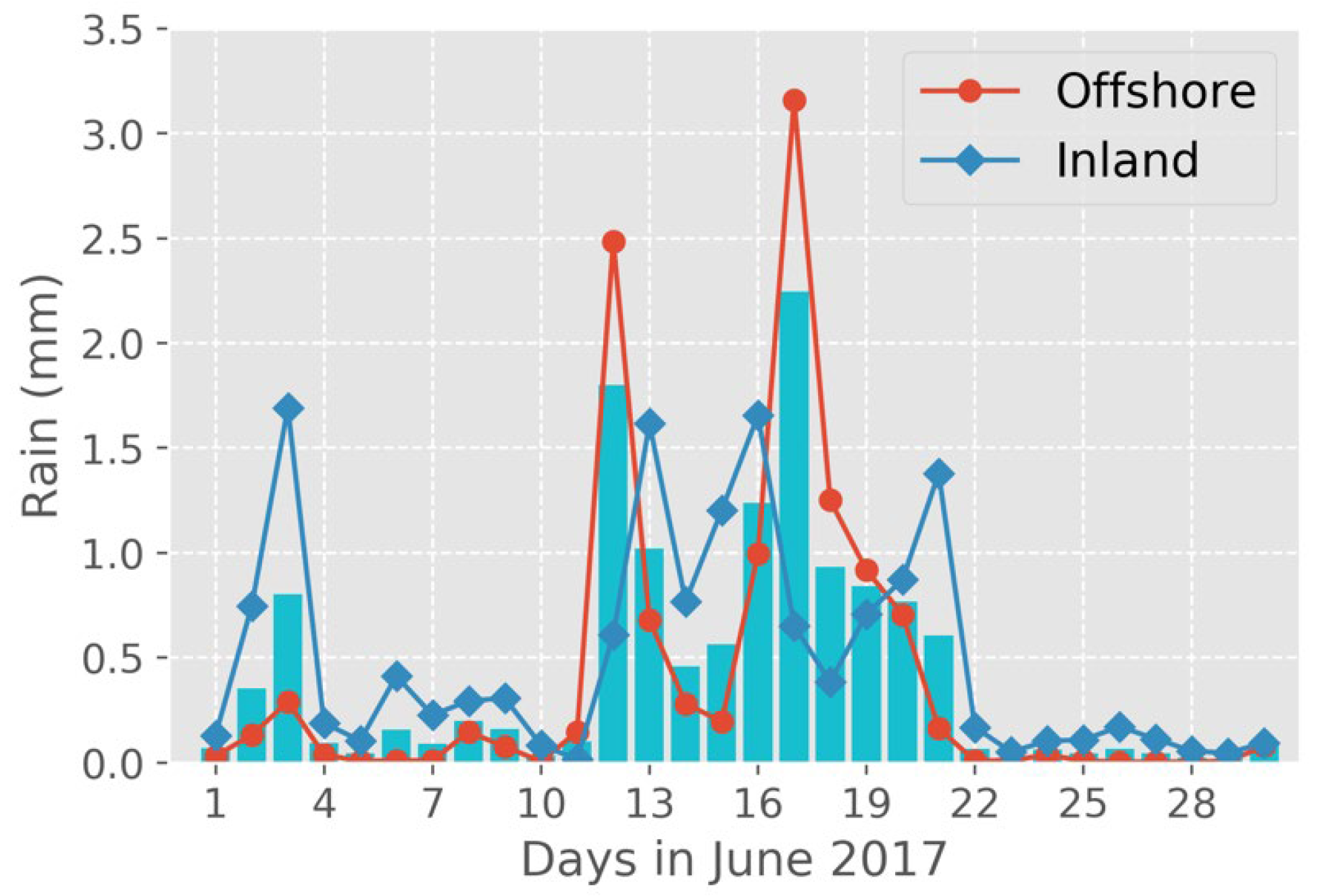
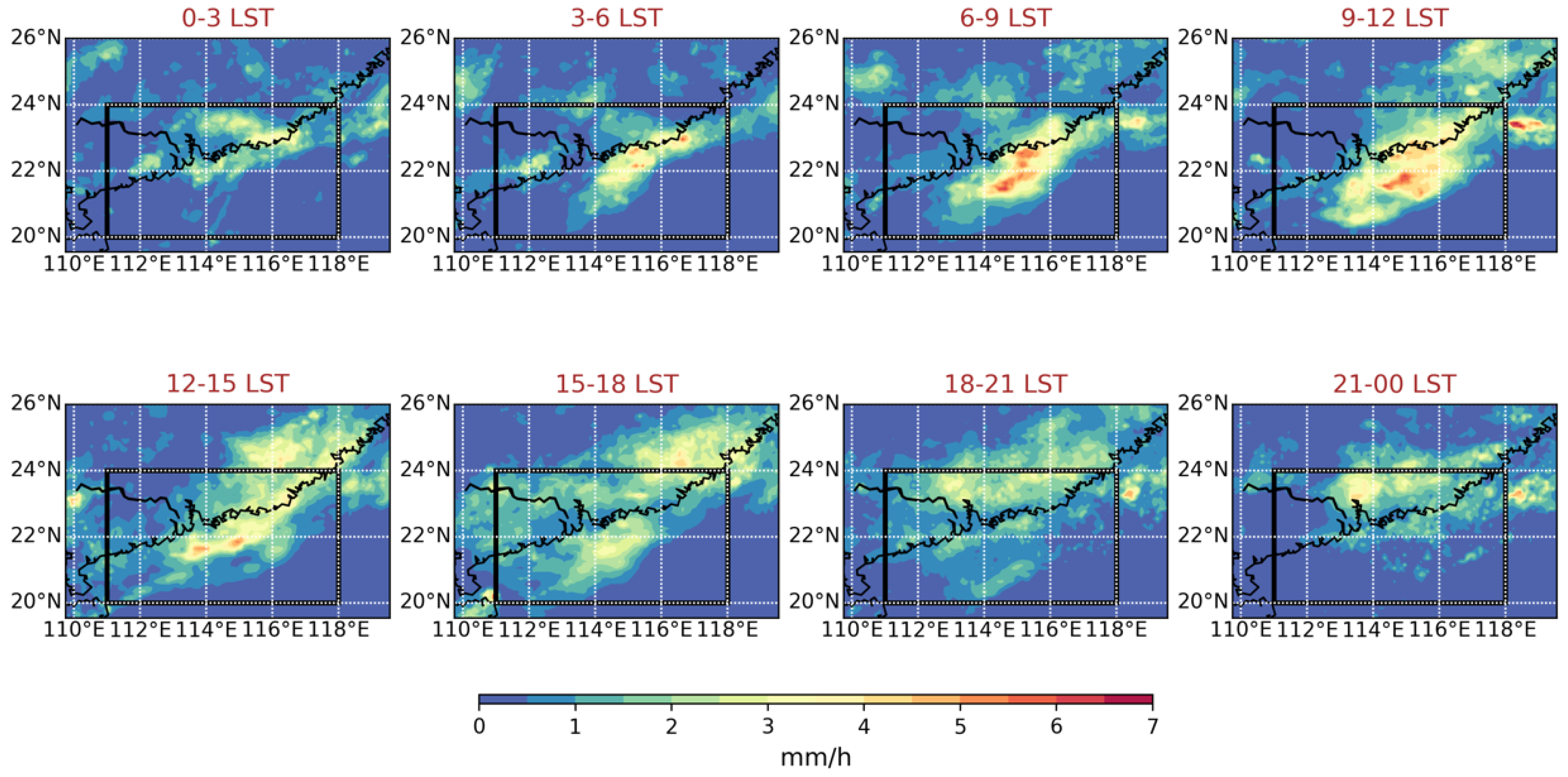
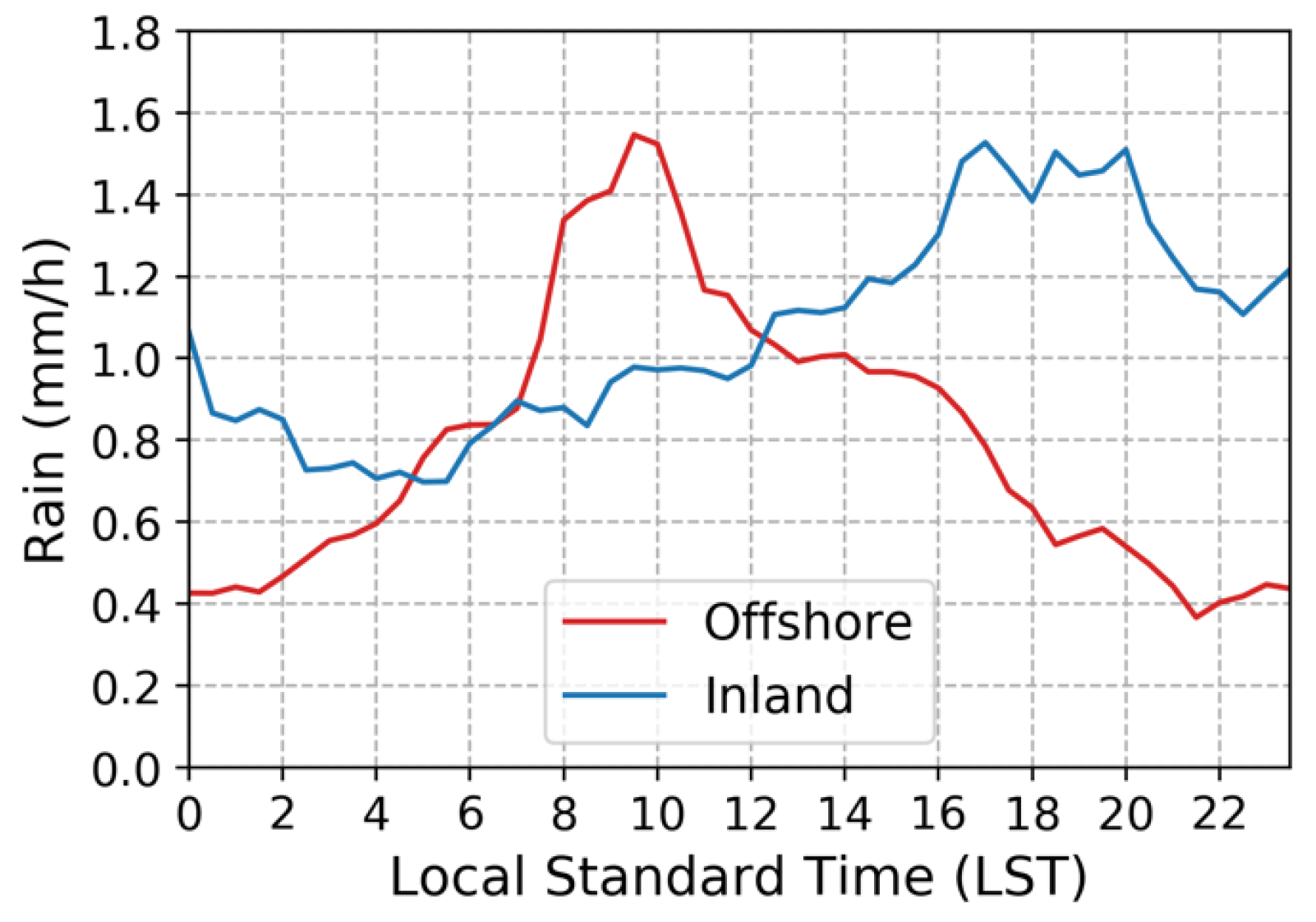

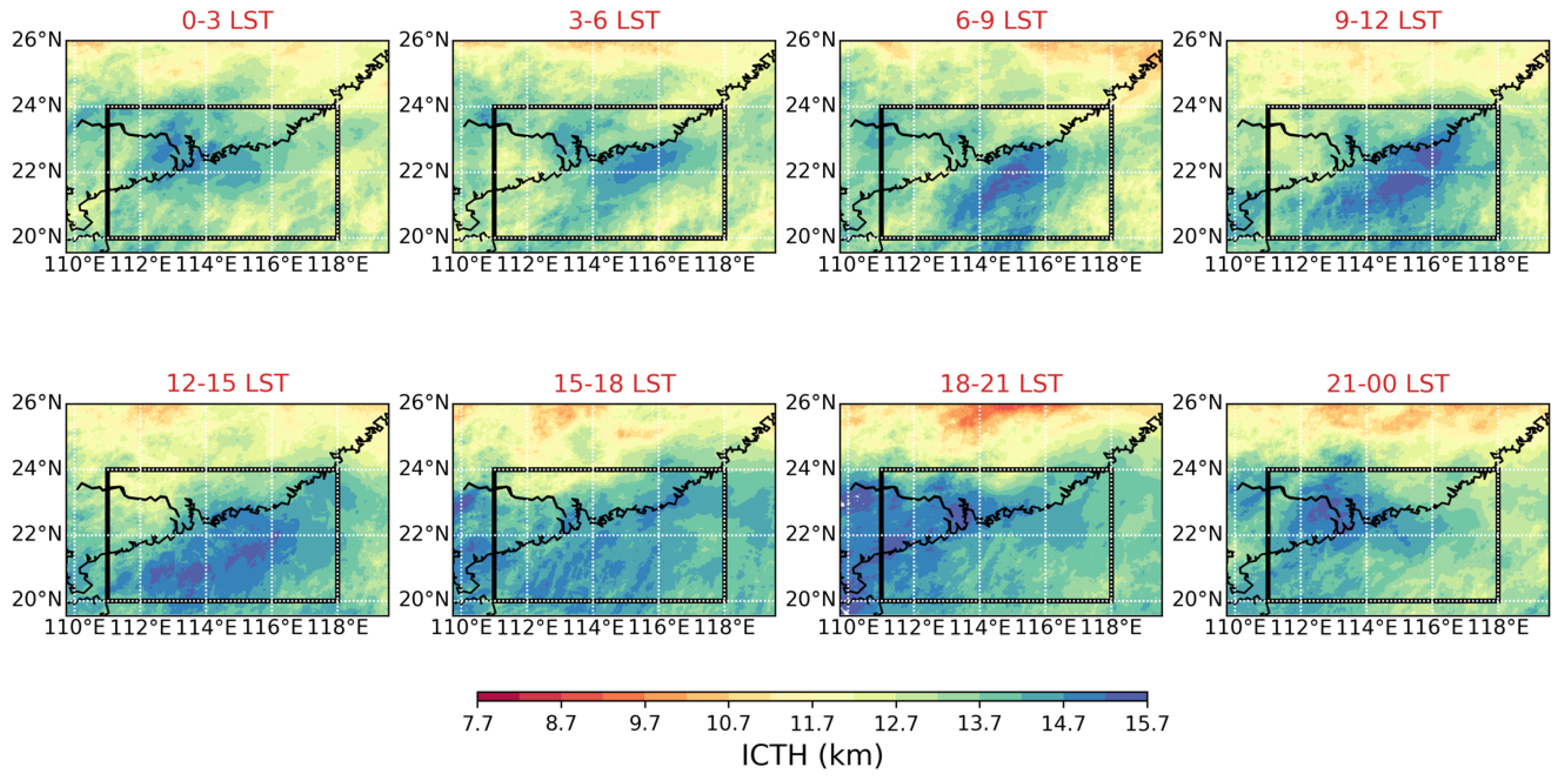
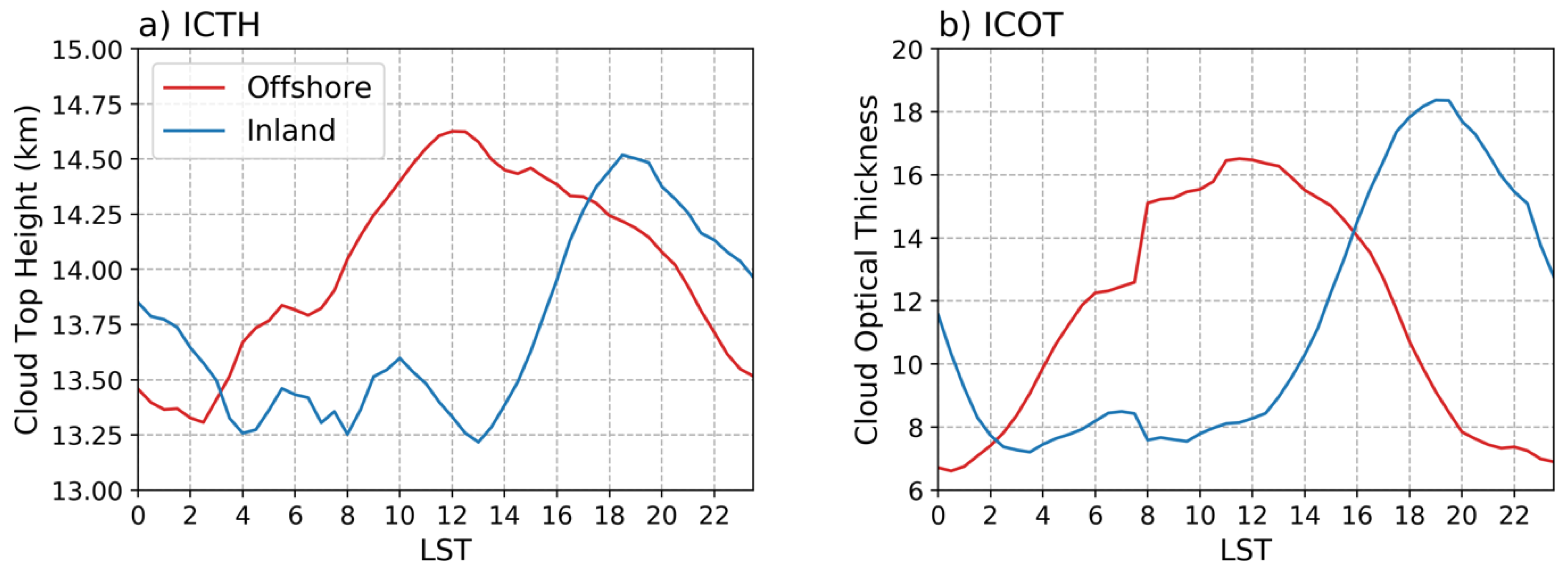
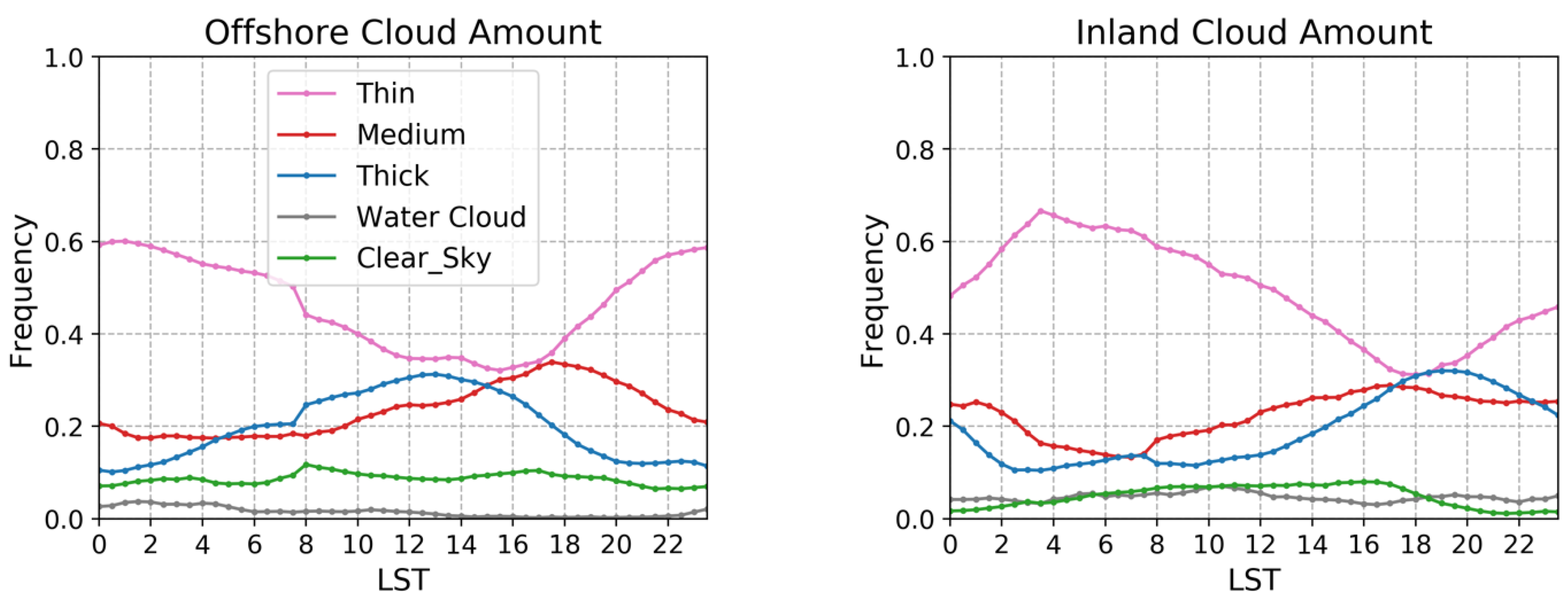
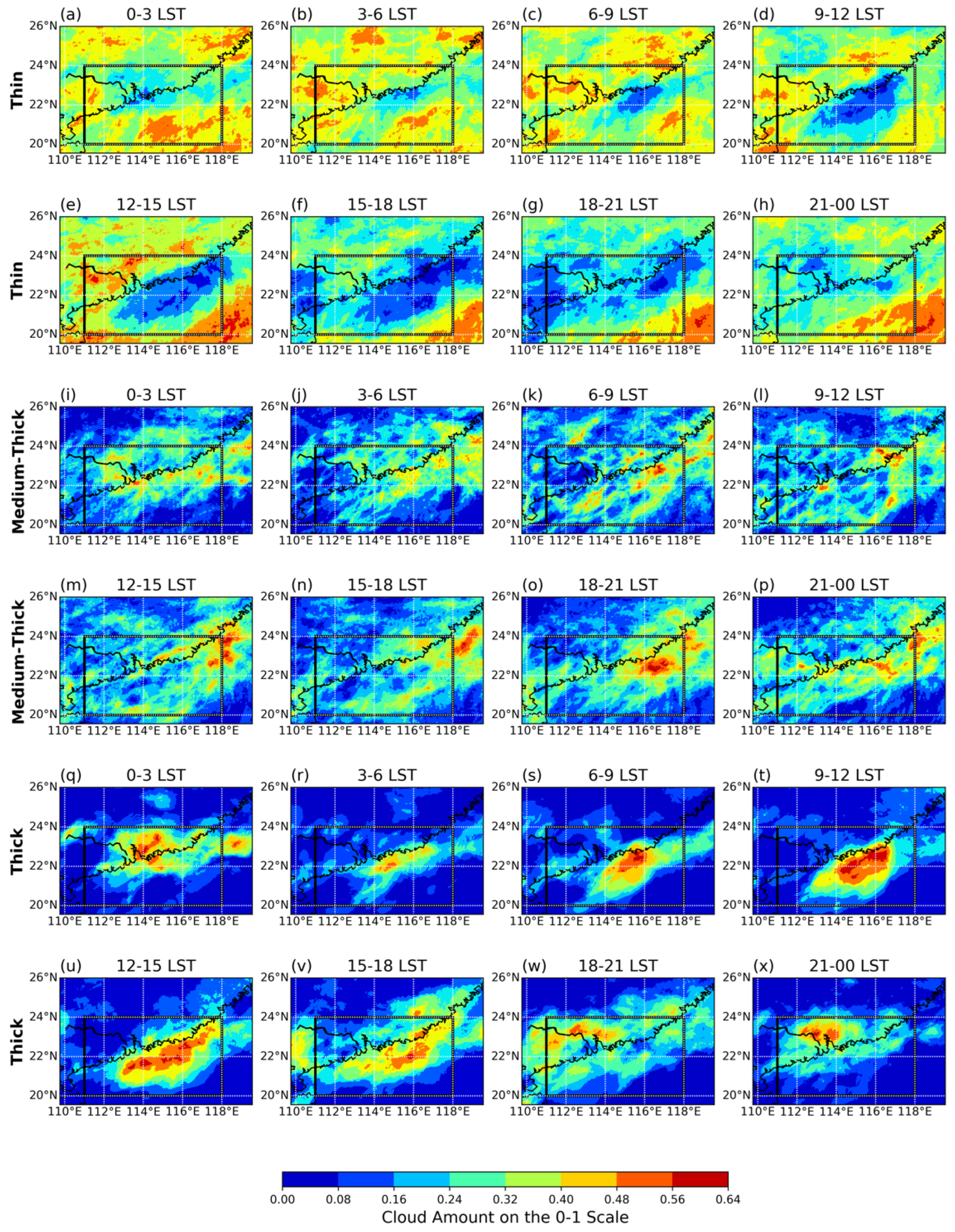
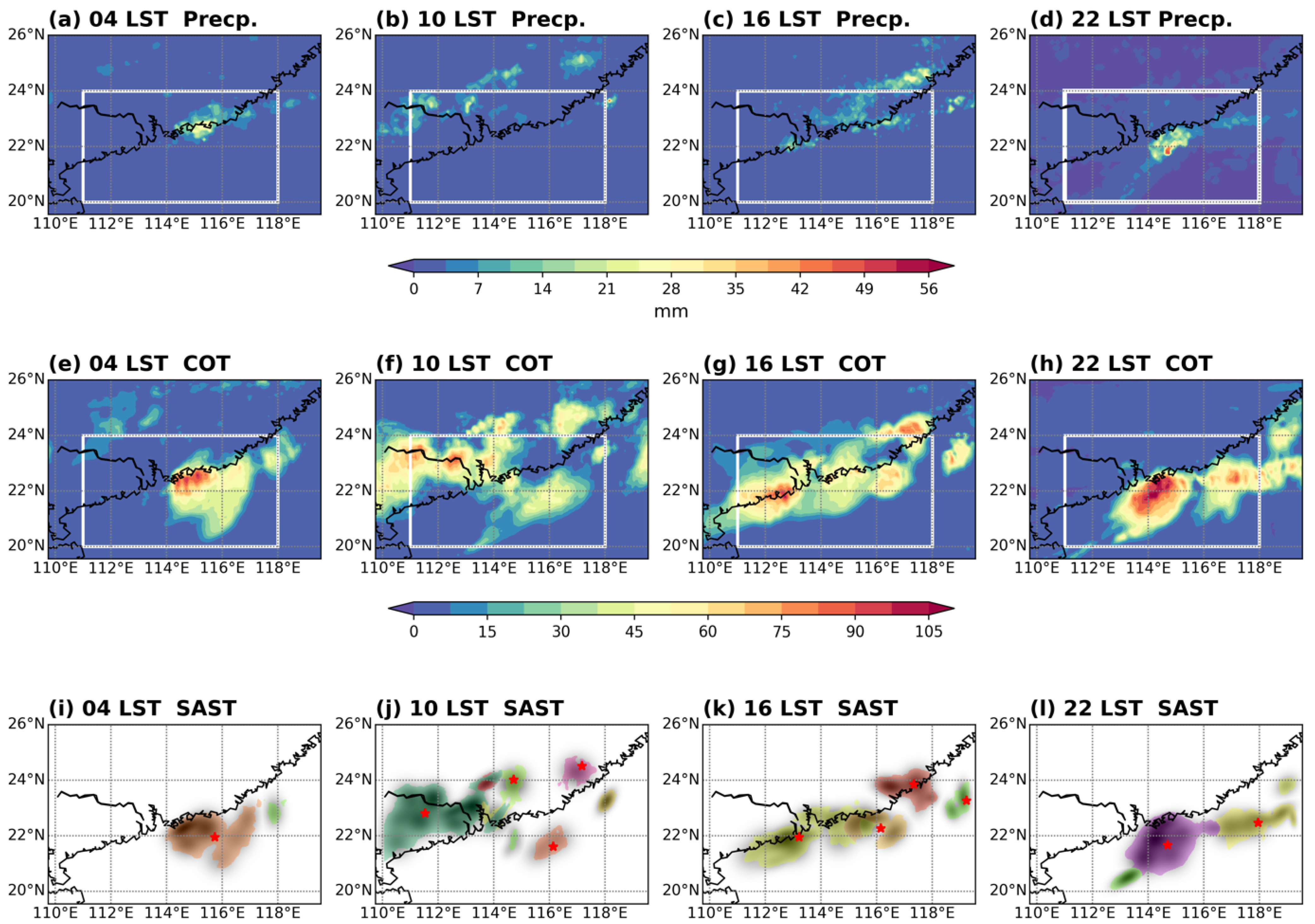
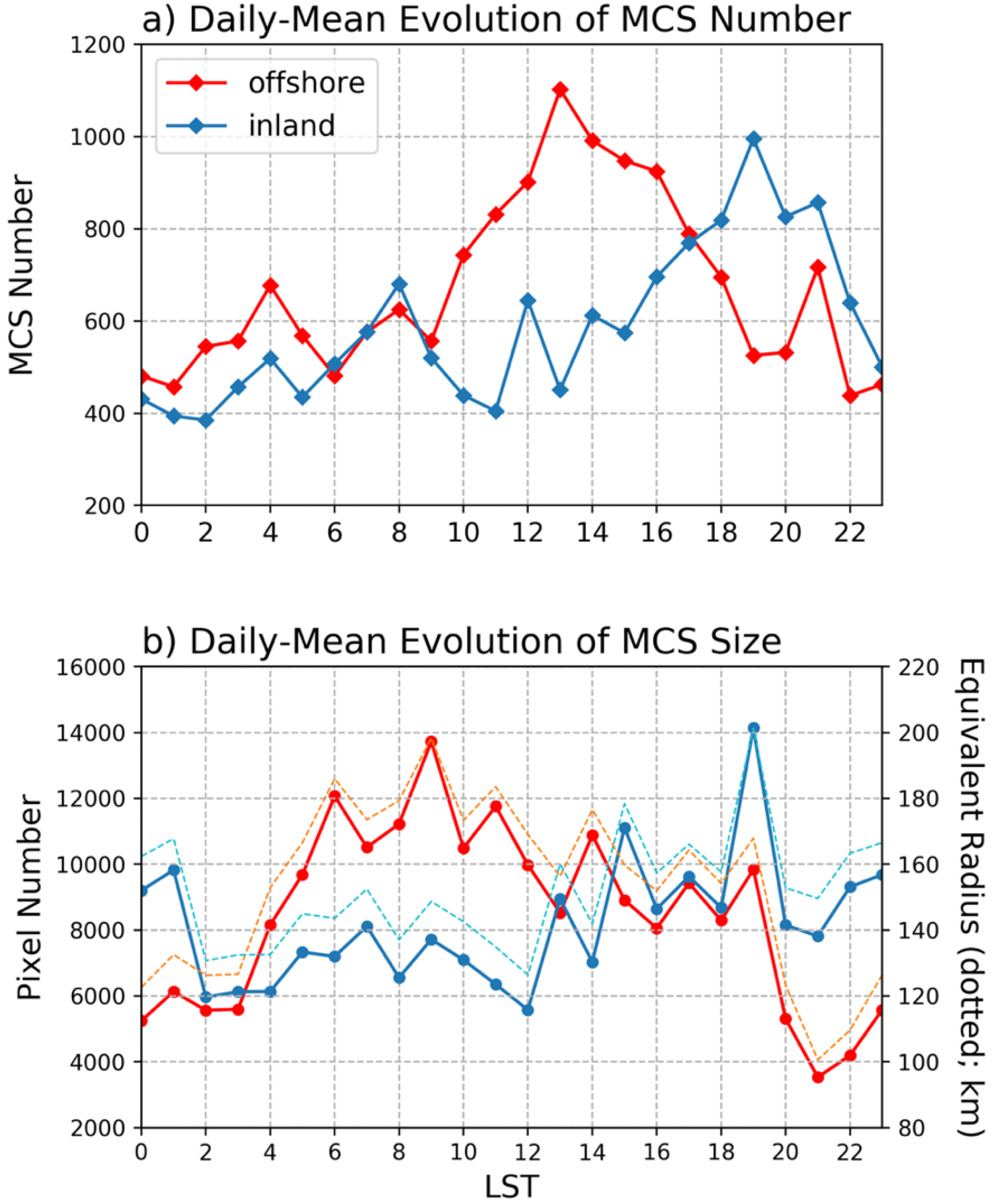
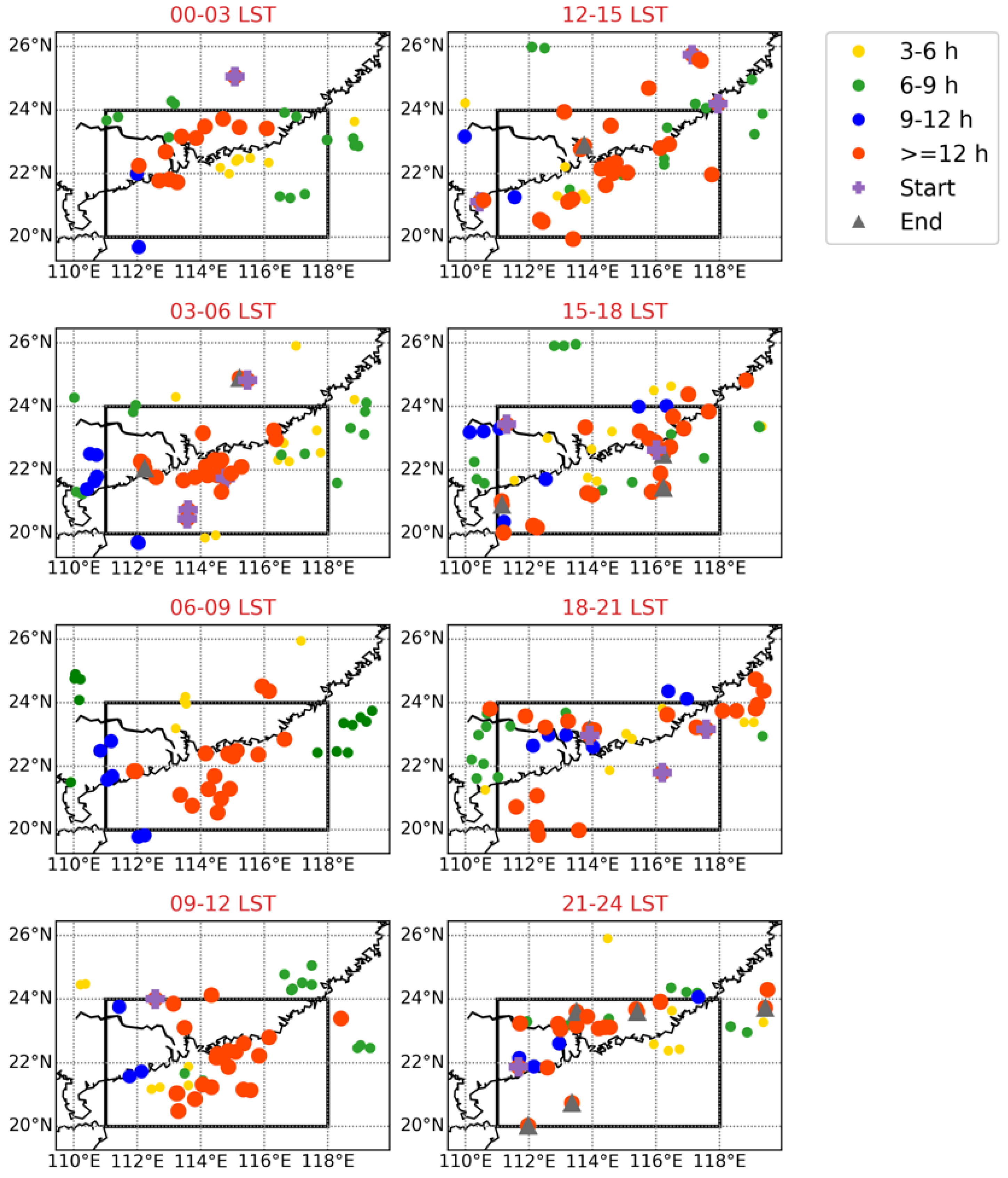
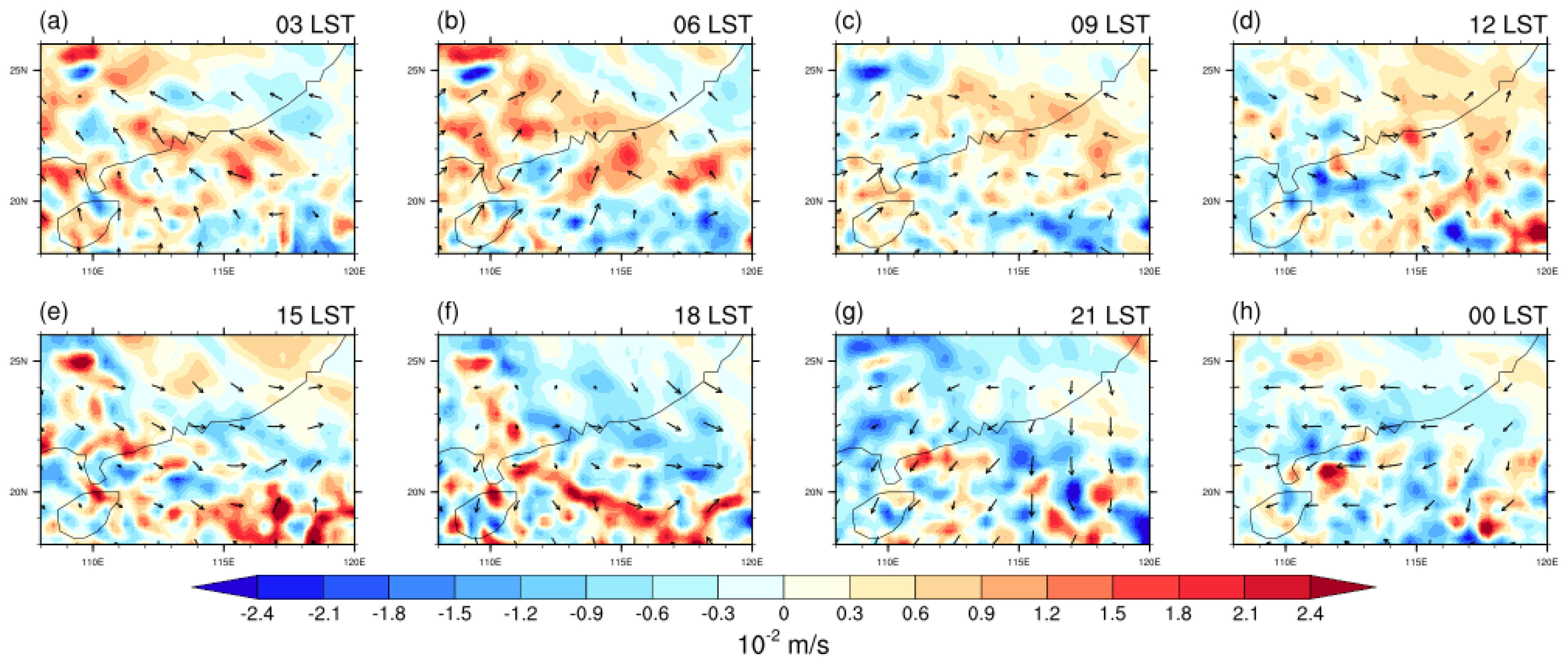
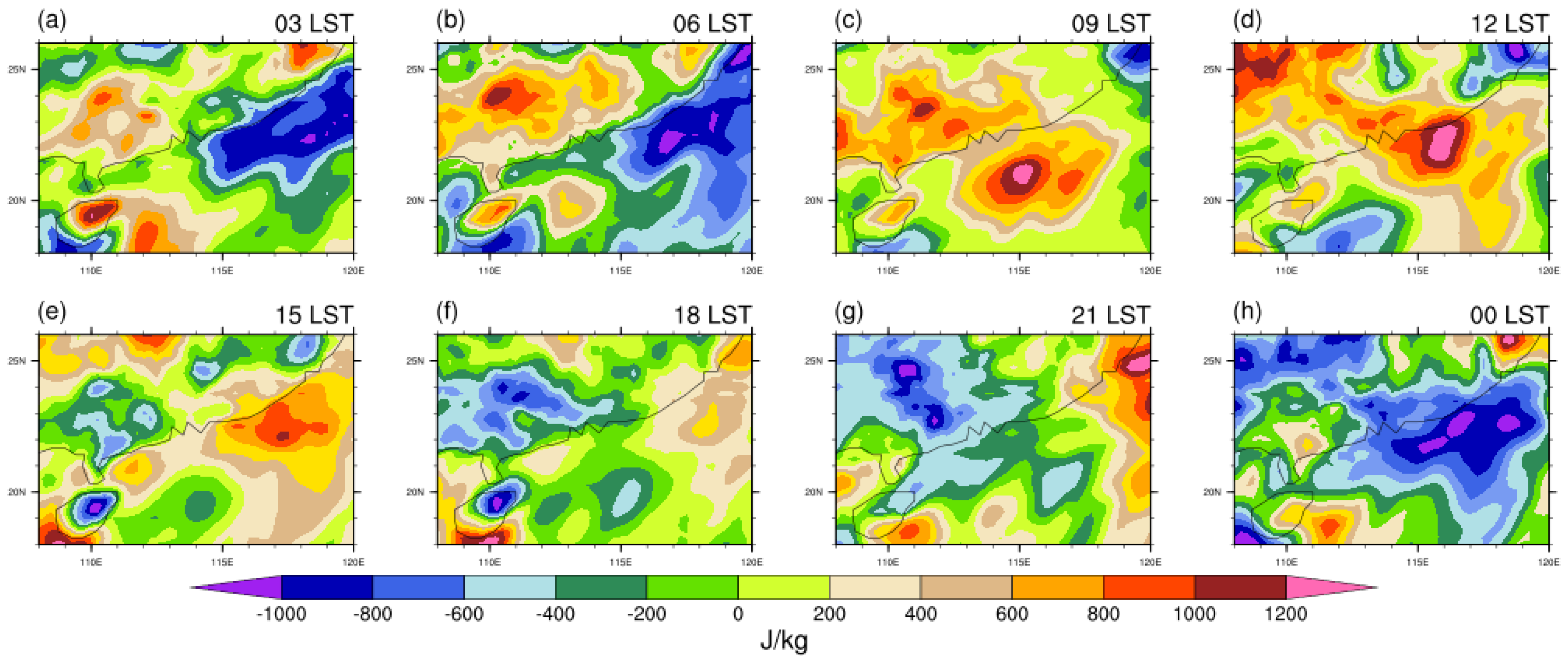
Publisher’s Note: MDPI stays neutral with regard to jurisdictional claims in published maps and institutional affiliations. |
© 2022 by the authors. Licensee MDPI, Basel, Switzerland. This article is an open access article distributed under the terms and conditions of the Creative Commons Attribution (CC BY) license (https://creativecommons.org/licenses/by/4.0/).
Share and Cite
Wang, X.; Iwabuchi, H.; Courbot, J.-B. Analysis of Diurnal Evolution of Cloud Properties and Convection Tracking over the South China Coastal Area. Remote Sens. 2022, 14, 5039. https://doi.org/10.3390/rs14195039
Wang X, Iwabuchi H, Courbot J-B. Analysis of Diurnal Evolution of Cloud Properties and Convection Tracking over the South China Coastal Area. Remote Sensing. 2022; 14(19):5039. https://doi.org/10.3390/rs14195039
Chicago/Turabian StyleWang, Xinyue, Hironobu Iwabuchi, and Jean-Baptiste Courbot. 2022. "Analysis of Diurnal Evolution of Cloud Properties and Convection Tracking over the South China Coastal Area" Remote Sensing 14, no. 19: 5039. https://doi.org/10.3390/rs14195039
APA StyleWang, X., Iwabuchi, H., & Courbot, J.-B. (2022). Analysis of Diurnal Evolution of Cloud Properties and Convection Tracking over the South China Coastal Area. Remote Sensing, 14(19), 5039. https://doi.org/10.3390/rs14195039




